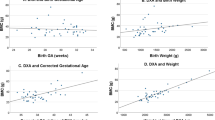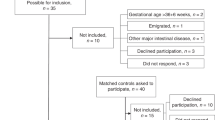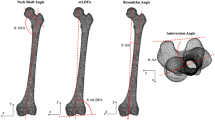Abstract
Objective:
To compare bone status of small-for-gestational age (SGA) versus appropriate-for-gestational age (AGA) newborn preterm infants.
Study design:
Tibial speed of sound (SOS) was measured in 144 infants categorized as SGA or AGA using the reference tables of Lubchenco et al. and Alexander et al.
Results:
By the Lubchenco tables, 22% of infants were SGA and 75% were AGA. The mean gestational ages of SGA and AGA were similar (33.3±2.6 and 32.5±2.4 weeks, respectively, P=0.09); however, SGA infant birth weights were lower (1329±392 and 1829±481 g, respectively, P<0.001). SOS values were higher for SGA versus AGA infants (3098±135 and 3003±122 m/s, respectively. P<0.001). Use of the Alexander tables yielded a twofold increase in the percent of infants categorized as SGA; SOS values remained significantly greater for SGA infants (P<0.001).
Conclusion:
Higher tibial SOS values in SGA versus AGA infants indicate greater bone strength.
This is a preview of subscription content, access via your institution
Access options
Subscribe to this journal
Receive 12 print issues and online access
$259.00 per year
only $21.58 per issue
Buy this article
- Purchase on Springer Link
- Instant access to full article PDF
Prices may be subject to local taxes which are calculated during checkout


Similar content being viewed by others
References
Resnik R, Creasy R . Intrauterine growth restriction. In: Creasy R, Resnik R (eds). Maternal–Fetal Medicine, 5th edn. Saunders: Philadelphia, PA, 2004 pp 495–512.
Hediger ML, Overpeck MD, Maurer KR, Kuczmarski RJ, McGlynn A, Davis WW . Growth of infants and young children born small or large for gestational age: findings from the Third National Health and Nutrition Examination Survey. Arch Pediatr Adolesc Med 1998; 152: 1225–1231.
Hack M, Schluchter M, Cartar L, Rahman M, Cuttler L, Borawski E . Growth of very low birth weight infants to age 20 years. Pediatrics 2003; 112: e30–e38.
Dalziel SR, Fenwick S, Cundy T, Parag V, Beck TJ, Rodgers A et al. Peak bone mass after exposure to antenatal betamethasone and prematurity: follow-up of a randomized controlled trial. J Bone Miner Res 2006; 21: 1175–1186.
Szathmari M, Vasarhelyi B, Szabo M, Szabo A, Reusz GS, Tulassay T . Higher osteocalcin levels and cross-links excretion in young men born with low birth weight. Calcif Tissue Int 2000; 67: 429–433.
Specker BL, Schoenau E . Quantitative bone analysis in children: current methods and recommendations. J Pediatr 2005; 146: 726–731.
Mimouni FB, Littner Y . Bone mass evaluation in children – comparison between methods. Pediatr Endocrinol Rev 2004; 1: 320–330.
Njeh CF, Fuerst T, Diessel E, Genant HK . Is quantitative ultrasound dependent on bone structure? A reflection. Osteoporos Int 2001; 12: 1–15.
Marin F, Gonzalez-Macias J, Diez-Perez A, Palma S, Delgado-Rodriguez M . Relationship between bone quantitative ultrasound and fractures: a meta-analysis. J Bone Miner Res 2006; 21: 1126–1135.
Pluskiewicz W, Halaba Z . Quantitative bone analysis in children: current methods and recommendations. J Pediatr 2006; 149: 430–431, author reply 431–432.
Baroncelli GI . Quantitative bone analysis in children: current methods and recommendations. J Pediatr 2006; 148: 704 author reply 704.
Zadik Z . Quantitative bone analysis in children: current methods and recommendations. J Pediatr 2006; 149: 429–430.
Kurl S, Heinonen K, Lansimies E . Effects of prematurity, intrauterine growth status, and early dexamethasone treatment on postnatal bone mineralisation. Arch Dis Child Fetal Neonatal Ed 2000; 83: F109–F111.
Teitelbaum JE, Rodriguez RJ, Ashmeade TL, Yaniv I, Osuntokun BO, Hudome S et al. Quantitative ultrasound in the evaluation of bone status in premature and full-term infants. J Clin Densitom 2006; 9: 358–362.
Koo WW, Walters J, Bush AJ, Chesney RW, Carlson SE . Dual-energy X-ray absorptiometry studies of bone mineral status in newborn infants. J Bone Miner Res 1996; 11: 997–1002.
Koo WW, Hockman EM . Physiologic predictors of lumbar spine bone mass in neonates. Pediatr Res 2000; 48: 485–489.
Tsukahara H, Sudo M, Umezaki M, Fujii Y, Kuriyama M, Yamamoto K et al. Measurement of lumbar spinal bone mineral density in preterm infants by dual-energy X-ray absorptiometry. Biol Neonate 1993; 64: 96–103.
Liao XP, Zhang WL, He J, Sun JH, Huang P . Bone measurements of infants in the first 3 months of life by quantitative ultrasound: the influence of gestational age, season, and postnatal age. Pediatr Radiol 2005; 35: 847–853.
Nemet D, Dolfin T, Wolach B, Eliakim A . Quantitative ultrasound measurements of bone speed of sound in premature infants. Eur J Pediatr 2001; 160: 736–740.
Pereda L, Ashmeade T, Zaritt J, Carver JD . The use of quantitative ultrasound in assessing bone status in newborn preterm infants. J Perinatol 2003; 23: 655–659.
Ashmeade T, Pereda L, Chen M, Carver JD . Longitudinal measurements of bone status in preterm infants. J Pediatr Endocrinol Metab 2007; 20: 415–424.
Chen JY, Ling UP, Chiang WL, Liu CB, Chanlai SP . Total body bone mineral content in small-for-gestational-age, appropriate-for-gestational-age, large-for-gestational-age term infants and appropriate-for-gestational-age preterm infants. Zhonghua Yi Xue Za Zhi (Taipei) 1995; 56: 109–114.
Lapillonne A, Braillon P, Claris O, Chatelain PG, Delmas PD, Salle BL . Body composition in appropriate and in small for gestational age infants. Acta Paediatr 1997; 86: 196–200.
Namgung R, Tsang RC, Specker BL, Sierra RI, Ho ML . Reduced serum osteocalcin and 1,25-dihydroxyvitamin D concentrations and low bone mineral content in small for gestational age infants: evidence of decreased bone formation rates. J Pediatr 1993; 122: 269–275.
Petersen S, Gotfredsen A, Knudsen FU . Total body bone mineral in light-for-gestational-age infants and appropriate-for-gestational-age infants. Acta Paediatr Scand 1989; 78: 347–350.
Pohlandt F, Mathers N . Bone mineral content of appropriate and light for gestational age preterm and term newborn infants. Acta Paediatr Scand 1989; 78: 835–839.
Minton SD, Steichen JJ, Tsang RC . Decreased bone mineral content in small-for-gestational-age infants compared with appropriate-for-gestational-age infants: normal serum 25-hydroxyvitamin D and decreasing parathyroid hormone. Pediatrics 1983; 71: 383–388.
Chunga Vega F, Gomez de Tejada MJ, Gonzalez Hachero J, Perez Cano R, Coronel Rodriguez C . Low bone mineral density in small for gestational age infants: correlation with cord blood zinc concentrations. Arch Dis Child Fetal Neonatal Ed 1996; 75: F126–F129.
Littner Y, Mandel D, Mimouni FB, Dollberg S . Bone ultrasound velocity of infants born small for gestational age. J Pediatr Endocrinol Metab 2005; 18: 793–797.
Littner Y, Mandel D, Mimouni FB, Dollberg S . Decreased bone ultrasound velocity in large-for-gestational-age infants. J Perinatol 2004; 24: 21–23.
Regev RH, Dolfin T, Eliakim A, Arnon S, Bauer S, Nemet D et al. Bone speed of sound in infants of mothers with gestational diabetes mellitus. J Pediatr Endocrinol Metab 2004; 17: 1083–1088.
Lubchenco LO, Hansman C, Dressler M, Boyd E . Intrauterine growth as estimated from liveborn birth-weight data at 24 to 42 weeks of gestation. Pediatrics 1963; 32: 793–800.
Alexander GR, Himes JH, Kaufman RB, Mor J, Kogan M . A United States national reference for fetal growth. Obstet Gynecol 1996; 87: 163–168.
Eliakim A, Dolfin T, Weiss E, Shainkin-Kestenbaum R, Lis M, Nemet D . The effects of exercise on body weight and circulating leptin in premature infants. J Perinatol 2002; 22: 550–554.
Litmanovitz I, Dolfin T, Friedland O, Arnon S, Regev R, Shainkin-Kestenbaum R et al. Early physical activity intervention prevents decrease of bone strength in very low birth weight infants. Pediatrics 2003; 112: 15–19.
Moyer-Mileur L, Luetkemeier M, Boomer L, Chan GM . Effect of physical activity on bone mineralization in premature infants. J Pediatr 1995; 127: 620–625.
Palacios J, Rodriguez S, Rodriguez JI . Intra-uterine long bone growth in small-for-gestational-age infants. Eur J Pediatr 1992; 151: 304–307.
Harrast SD, Kalkwarf HJ . Effects of gestational age, maternal diabetes, and intrauterine growth retardation on markers of fetal bone turnover in amniotic fluid. Calcif Tissue Int 1998; 62: 205–208.
Namgung R, Tsang RC . Bone in the pregnant mother and newborn at birth. Clin Chim Acta 2003; 333: 1–11.
Sievanen H, Backstrom MC, Kuusela AL, Ikonen RS, Maki M . Dual energy x-ray absorptiometry of the forearm in preterm and term infants: evaluation of the methodology. Pediatr Res 1999; 45: 100–105.
Prevrhal S, Fuerst T, Fan B, Njeh C, Hans D, Uffmann M et al. Quantitative ultrasound of the tibia depends on both cortical density and thickness. Osteoporos Int 2001; 12: 28–34.
Fricke O, Tutlewski B, Schwahn B, Schoenau E . Speed of sound: relation to geometric characteristics of bone in children, adolescents, and adults. J Pediatr 2005; 146: 764–768.
Rodrigues T, Teles TP, Miguel C, Pereira A, Barros H . [Small for gestational age newborn infants. The effect of standard curves of birth weight on the calculation of the prevalence and of the risk factors]. Acta Med Port 1996; 9: 335–340.
Author information
Authors and Affiliations
Corresponding author
Rights and permissions
About this article
Cite this article
Chen, M., Ashmeade, T. & Carver, J. Bone ultrasound velocity in small- versus appropriate-for-gestational age preterm infants. J Perinatol 27, 485–489 (2007). https://doi.org/10.1038/sj.jp.7211769
Received:
Revised:
Accepted:
Published:
Issue Date:
DOI: https://doi.org/10.1038/sj.jp.7211769



